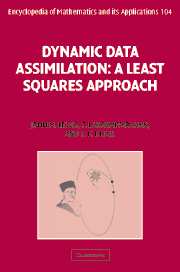Book contents
- Frontmatter
- Contents
- Preface
- Acknowledgements
- PART 1 GENESIS OF DATA ASSIMILATION
- PART II DATA ASSIMILATION: DETERMINISTIC/STATIC MODELS
- PART III COMPUTATIONAL TECHNIQUES
- PART IV STATISTICAL ESTIMATION
- PART V DATA ASSIMILATION: STOCHASTIC/STATIC MODELS
- PART VI DATA ASSIMILATION: DETERMINISTIC/DYNAMIC MODELS
- 22 Dynamic data assimilation: the straight line problem
- 23 First-order adjoint method: linear dynamics
- 24 First-order adjoint method: nonlinear dynamics
- 25 Second-order adjoint method
- 26 The 4DVAR problem: a statistical and a recursive view
- PART VII DATA ASSIMILATION: STOCHASTIC/DYNAMIC MODELS
- PART VIII PREDICTABILITY
- Epilogue
- References
- Index
26 - The 4DVAR problem: a statistical and a recursive view
from PART VI - DATA ASSIMILATION: DETERMINISTIC/DYNAMIC MODELS
Published online by Cambridge University Press: 18 December 2009
- Frontmatter
- Contents
- Preface
- Acknowledgements
- PART 1 GENESIS OF DATA ASSIMILATION
- PART II DATA ASSIMILATION: DETERMINISTIC/STATIC MODELS
- PART III COMPUTATIONAL TECHNIQUES
- PART IV STATISTICAL ESTIMATION
- PART V DATA ASSIMILATION: STOCHASTIC/STATIC MODELS
- PART VI DATA ASSIMILATION: DETERMINISTIC/DYNAMIC MODELS
- 22 Dynamic data assimilation: the straight line problem
- 23 First-order adjoint method: linear dynamics
- 24 First-order adjoint method: nonlinear dynamics
- 25 Second-order adjoint method
- 26 The 4DVAR problem: a statistical and a recursive view
- PART VII DATA ASSIMILATION: STOCHASTIC/DYNAMIC MODELS
- PART VIII PREDICTABILITY
- Epilogue
- References
- Index
Summary
In Chapters 22–25 we have discussed the solution to the off-line, 4DVAR problem of assimilating a given set of observations in deterministic/dynamic models using the classical least squares (Part II) method. In this framework, the adjoint method facilitates the computation of the gradient of the least squares objective function, which when used in conjunction with the minimization methods described in Part III, leads to the optimal initial conditions for the dynamic model. Even in the ideal case of a perfect dynamic model (error free model), the computed values of the optimal initial condition are noisy in response to erroneous observations. The deterministic approach in Chapter 22–25 are predicated on the assumption that the statistical properties of the noise corrupting the observations are not known a priori. The question is: if we are given additional information, say the second-order properties (mean and covariance) of the noisy observations, how can we use this information to derive the second-order properties of the optimal initial conditions? This can only be achieved by reliance on the statistical least squares method described in Chapter 14.
The goal of this chapter is two fold. The first is to apply the statistical least squares method of Chapter 14. More specifically, we derive explicit expressions for the unbiased, optimal (least squares) estimate of the initial condition and its covariance when the model is linear and the observations are a linear function of the state.
- Type
- Chapter
- Information
- Dynamic Data AssimilationA Least Squares Approach, pp. 445 - 460Publisher: Cambridge University PressPrint publication year: 2006

